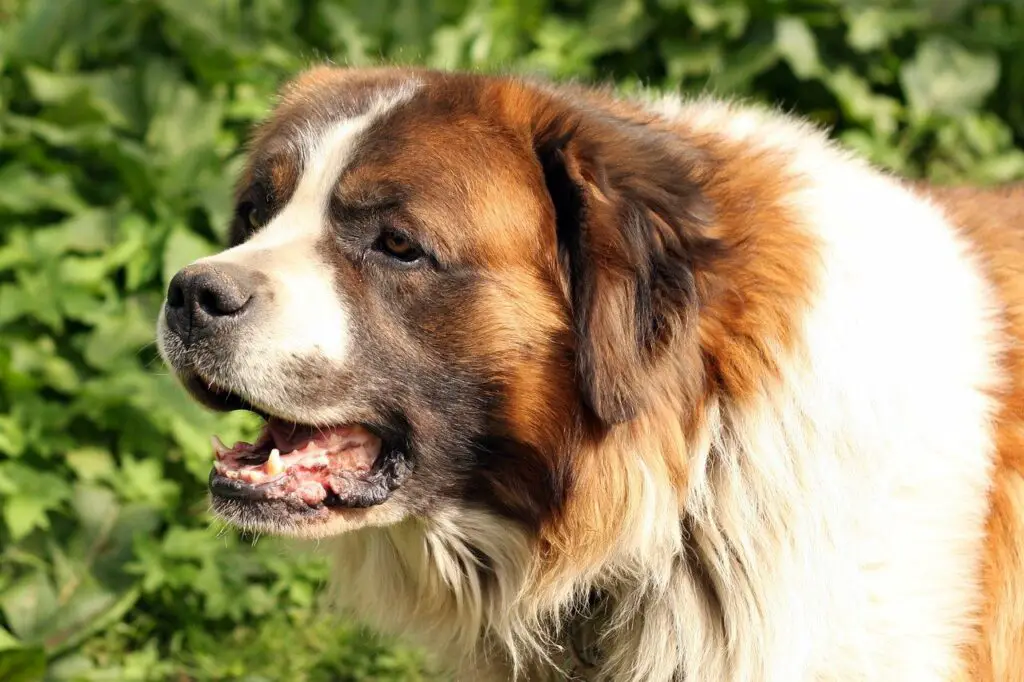Having a furry friend means regular vacuuming because of the constant shedding.
If you are a new St. Bernard breed owner, you know them to be kind, loving and have a sweet temperament.
The only question you might have is, will my dog shed?
So, do St. Bernard’s shed?
Yes.
They are heavy shedders and usually lose their fur twice a year, during spring and autumn.
Shedding prepares them for the coming seasons of summer and winter.
The heavy shedding is due to their dense, thick double coat.
Apart from the seasonal shedding, they also shed lightly throughout the year.
This article deep dives into the types of coats St. Bernards have, the shedding period, other reasons why they shed, and how to reduce excessive shedding in the dogs.

St. Bernards coat types
St. Bernards have two types of coats: short-haired and long-haired.
The short-haired coat is smooth, dense, and slightly bushy on the dog’s thighs.
The tail of the short-haired St. Bernard’s coat is covered in long, lush hair that is shorter towards the end.
The long-haired coat is slightly wavy.
The forelegs of a long-haired St. Bernard dog have slight feathering, and the thighs and tails are bushy.
The long-haired and short-haired coats can either be smooth or rough.
Both coats are dense to protect them from harsh winters.
Rough coat hairs are longer than smooth coats and take longer to groom.
The thick coat in St. Bernards causes them to shed so much.

Which periods do St. Bernards shed?
St. Bernards tend to shed a lot during spring and autumn.
Shedding is a natural process that they must undergo to get rid of old or damaged hair in their undercoat.
A new thick undercoat grows as the winter season progresses, pushing out older hair to protect against the cold.
During spring, your St. Bernard will lose the coat for better body temperature regulation during summertime.
Other reasons why St. Bernards shed
Apart from seasonal shedding, St. Bernard’s can also shed due to a number of different reasons that include:
- Poor nutrition – An imbalanced diet, one not containing protein or fat, will lead to dull, dry, and brittle hair coat on a St. Bernard as it does not meet its dietary needs. Dehydration also contributes to excessive shedding.
- Parasites – Fleas, ticks, and termites will irritate St. Bernard’s skin, causing it to scratch or bite the area for relief, leading to excessive shedding.
- Allergic reaction – St. Bernards can shed due to an allergic reaction to a medicine, pollen in the air, and food such as dairy or wheat. The allergic reaction will cause the dog to scratch or bite its skin
- Pregnancy – The female St. Bernard will shed excessively during pregnancy due to the shortage of essential minerals needed to maintain a healthy coat.
- Serious illness – Kidney or liver diseases, cancer, and immune diseases will cause unhealthy coat shedding in your St. Bernard.
How to reduce shedding in a St. Bernard
Brushing
Whether your St. Bernard has a rough or smooth coat, you’ll have to brush it regularly.
A long-haired St. Bernard will develop tangles and knots on its fur, so brushing daily during autumn and spring will be important.
Brushing 3 to 4 times a week is enough when it’s not their peak shedding period.
Regular brushing aims to help St. Bernards shed less and reduce the chances of knots and tangles occurring on its coat.
Type of brush to use in brushing a St. Bernard
Bristle brush – It will be good on both the rough and smooth coats.
Choose a brush with widely spaced and longer bristles if your St. Bernard is long-haired.
Brush the rough coats with stiff bristles.
Balanced diet
A healthy diet will play a big role in maintaining a St. Bernard’s coat.
When essential minerals and vitamins are missing from the dog’s diet, it will cause shedding.
Ensure you feed your St. Bernard foods rich in omega fatty acids, biotin, vitamin B2, zinc, and copper.
Such foods include eggs, almonds, chia seeds, liver, salmon, peanut butter, and apples.
Fish oil supplements are also rich in omega-3 and omega-6 and have anti-inflammatory properties that promote soft, silky coats in dogs.
Regular water intake
If your St. Bernard is in its shedding period, ensure you increase the amount of water it drinks.
Dehydrated skin causes major hair loss.
Frequent bathing
Bathing your St. Bernard will help remove dead hair a3nd prevent it from mixing with healthy hair.
The dog shampoos and conditioners contain omega fatty acids that will hydrate your dog’s coat and promote healthy, strong follicles.
The shampoo and conditioners also loosen the St. Bernard undercoat, making it easy to remove during brushing.
Tips to consider when your St. Bernard sheds
- Use a shampoo and conditioner that doesn’t contain artificial fragrances as they can irritate the St. Bernard’s eyes and skin.
- During bathing, the shampoo and conditioner you use on your St. Bernard should have ingredients like oatmeal, aloe vera, herbal proteins, vitamins, omega-3, and omega-6 fatty acids to help maintain a healthy coat.
- If your St. Bernard is shedding more than what is normal or has unusual patches on its coat, visit your vet immediately.
- Balance all the meals that you intend to feed your St. Bernard. Ensure they get their daily dose of omega fatty acids, riboflavin, and vitamin B2 by mixing different food rich in essential vitamins to promote a shiny and healthy coat.
- Brush your St. Bernard before giving it a bath to help reduce the tangles on its coat.
Frequently Asked Questions (FAQs)
Can a St. Bernard be given a haircut?
No, a St. Bernard cannot be given a haircut as it is unhealthy for the dog.
The coat keeps the St. Bernard warm during winter and protects it from hot temperatures.
It would be best to trim the coat only when directed by your vet.
Can I use human shampoo for bathing a St. Bernard?
No, you cannot use human shampoo for bathing your St. Bernard as it contains harmful chemicals that will make your dog’s skin dry and flaky, leading to repeated scratching and excess shedding.
To wrap up
A St. Bernard will shed heavily during autumn and spring, but light shedding will happen during other times of the year.
If you are looking to adopt or buy one, ensure you maintain its coat well by brushing, bathing, and giving the dog a balanced diet and enough water.
Constant vacuuming will be part of your routine too.
- What Dog Breeds Have Pink Skin? - March 24, 2023
- What Are the Most Inspiring Dog Breeding Quotes? - March 20, 2023
- Can Pheromone Spray Help Improve Dog Breeding Results? - March 19, 2023








